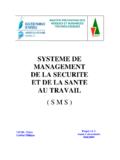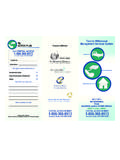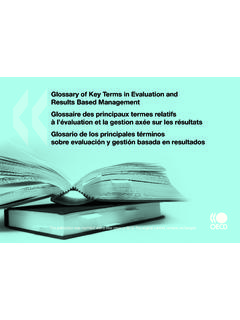Transcription of Voluntary Guidelines for Sustainable Soil Management
1 Voluntar y Guidelinesfor SustainableSoil ManagementVoluntary Guidelines for Sustainable soil ManagementFOOD AND AGRICULTURE ORGANIZATION OF THE UNITED NATIONSRome, 2017 The present VGSSM is the result of an inclusive and participatory process that involved multiple stakeholders - including academic, national and research institutions, international organizations, NGOs, civil society and the private sector who contributed with scientific knowledge and experience on how soils should be sustainably managed for properly delivering ecosystem services while halting y Guidelines for Sustainable soil ManagementDisclaimer and CopyrightRecommended citation:FAO 2017. Voluntary Guidelines for Sustainable soil Management Food and Agriculture Organization of the United NationsRome, Italy The designations employed and the presentation of material in this information product do not imply the expression of any opinion whatsoever on the part of the Food and Agriculture Organization of the United Nations (FAO) concerning the legal or development status of any country, territory, city or area or of its authorities, or concerning the delimitation of its frontiers or boundaries.
2 The mention of specific companies or products of manufacturers, whether or not these have been patented, does not imply that these have been endorsed or recommended by FAO in preference to others of a similar nature that are not mentioned. The views expressed in this information product are those of the author(s)and do not necessarily reflect the views or policies of FAO. FAO, 2017 FAO encourages the use, reproduction and dissemination of material in this information product. Except where otherwise indicated, material may be copied, downloaded and printed for private study, research and teaching purposes, or for use in non-commercial products or services, provided that appropriate acknowledgement of FAO as the source and copyright holder is given and that FAO s endorsement of users views, products or services is not implied in any way. All requests for translation and adaptation rights, and for resale and other commercial use rights should be made via or addressed to FAO information products are available on the FAO website can be purchased through V1.
3 Introduction 1 Background and rationale 1 Objectives 2 Nature and scope 2 Target audience 2 Definition of Sustainable soil Management 32. Challenges for achieving Sustainable soil Management 53. Guidelines for Sustainable soil Management 7 Minimize soil erosion 7 Enhance soil organic matter content 8 Foster soil nutrient balance and cycles 8 Prevent, minimize and mitigate soil salinization and alkalinization 10 Prevent and minimize soil contamination 10 Prevent and minimize soil acidification 11 Preserve and enhance soil biodiversity 11 Minimize soil sealing 12 Prevent and mitigate soil compaction 12 Improve soil water Management 134. Dissemination, use and evaluation of the VGSSM 15 FAO/Paballo ThekisoVForewordForewordHumankind is facing tremendous challenges in agriculture: the climate is changing, the global population is growing quickly, cities are expanding, diets are undergoing major shifts and soils are becoming increasingly degraded.
4 In this fast-changing world, and given the urgent need to eliminate hunger and ensure food security and nutrition, understanding and attaining Sustainable soil Management has never been more important. Indeed, the Sustainable Development Goals identify the need to restore degraded soils and improve soil health. There is widespread agreement that we must nurture and unlock the full potential of soils, so as to be able to not only support food production but also to store and supply more clean water, maintain biodiversity, sequester carbon and increase resilience in a changing climate. This is a goal that requires the universal implementation of Sustainable soil Management . Soils are the foundation of food production and many essential ecosystem services. It has been shown that Sustainable soil Management contributes to increasing food production, enhancing the nutrient content of food, and adapting to and mitigating climate change.
5 The conservation and responsible Management of soils is thus central to FAO s mandate to help eliminate hunger, food insecurity and malnutrition. To ensure greater recognition of the essential contributions of soils to agriculture and food production, as well as their crucial ecosystem services, the FAO Council established the Global soil Partnership (GSP) in December 2012, as a coalition of willing partners to promote and implement Sustainable soil Management at all scales, from local to global. Since then, the GSP has been conducting a vigorous campaign to promote Sustainable soil Management . Under the aegis of the GSP, the World soil Charter, which contains key principles and guidance for action towards Sustainable soil Management , was revised in 2015, in light of major policy and scientific developments over the past three decades.
6 In turn, these Voluntar y Guidelines for Sustainable soil Management , endorsed by the FAO Council in December 2016 at its 155th Session, complement the World soil Charter by further elaborating principles and practices for incorporation into policies and decision-making. I expect this timely tool to both guide practitioners and help generate the necessary support to dramatically increase the area under Sustainable soil Management worldwide. I commend the collaborative and inclusive efforts that enabled the development of these Voluntary Guidelines . FAO strongly encourages their uptake, and is ready to continue supporting Members in implementing effective policies and actions towards healthy soils. JOSE GRAZIANO DA SILVAFAO Director-General FAO/Ronald Vargas11. Introduction1. IntroductionThese Voluntary Guidelines for Sustainable soil Management (VGSSM) were developed through an inclusive process within the framework of the Global soil Partnership (GSP).
7 They aim to be a reference providing general technical and policy recommendations on Sustainable soil Management (SSM) for a wide range of committed stakeholders. The Guidelines were adopted by the 4th GSP Plenary Assembly (Rome, 25 May 2016), approved by the 25th session of the FAO Committee on Agriculture (Rome, 28 September 2016) and finally endorsed by the 155th session of the FAO Council (Rome, 5 December 2016). Background and rationaleSoils are an essential and non-renewable natural resource hosting goods and services vital to ecosystems and human life. Soils are fundamental for producing crops, feed, fibre, fuel, and they filter and clean tens of thousands of cubic kilometers of water each year. As a major storehouse for carbon, soils also help regulate emissions of carbon dioxide and other greenhouse gases, which is fundamental for regulating climate.
8 SSM is an integral part of Sustainable land Management , as well as a basis for addressing poverty eradication, agricultural and rural development, promoting food security and improving is the world s largest terrestrial pool of carbon1,2 and approximately 95% of global food is produced in soil3. SSM is a valuable tool for climate change adaptation and a pathway for safeguarding key ecosystem services and biodiversity. Due to the incalculable value soils provide to society through ecosystem services, SSM ensures a high return on investment by supporting and increasing these services. Widespread adoption of SSM practices generates multiple socio-economic benefits, especially for smallholder farmers and large scale agricultural producers worldwide whose livelihoods directly depend on their soil , evidence recently provided in the Status of the World s soil Resources (SWSR) report and other studies shows that about 33% of global soils are moderately or highly degraded4,5, due to unsustainable Management practices.
9 On a global scale an annual loss of 75 billion tons of soil from arable land is estimated to cost about USD 400 billion each year in lost agricultural production6. This loss also significantly reduces the soil s ability to store and cycle carbon, nutrients, and water. Annual cereal production losses due to erosion have been estimated at 7. 6 m i l l i o n t o n n e s .Growing concerns about the state of global soils resulted, amongst others, in the establishment of the Global soil Partnership, the proclamation of the International Year of Soils (2015) by the UN General Assembly and the adoption of the revised World soil Charter by the FAO Conference. In a broader context, the 2030 Agenda for Sustainable Development adopted a number of related targets in 2015, those aimed at restoring degraded soil , striving to achieve a land degradation-neutral world and implementing resilient agricultural practices that progressively improve soil quality and minimize soil Carbon sequestration in dryland soils.
10 FAO, 20042 Land use, land use change, and forestry. Summary for policy-makers. IPCC, 2000 (pp. 3-4) 3 Healthy soils are the basis for healthy food production, FAO, Status of the World s soil Resources (SWSR). Main Report. FAO and ITPS, Rome, 2015 (p. xix)5 The state of the world s land and water resources for food and agriculture (SOLAW). Managing systems at risk. FAO, Rome and Earthscan, London, 2011 (p. 113).6 The value of land: Prosperous lands and positive rewards through Sustainable land Management . The Economics of Land Degradation (ELD) Initiative, 2015 (p. 80).2 Voluntar y Guidelines for Sustainable soil ManagementSSM strongly contributes to collective efforts towards climate change adaptation and mitigation, combating desertification and promoting biodiversity, and therefore has specific relevance to the United Nations Framework Convention on Climate Change (UNFCCC), United to Combat Desertification (UNCCD) and United Nations Convention on Biological Diversity (UNCBD).















